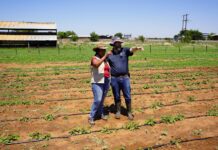United States of America Joe Biden assured Africa of unfettered assistance towards Africa’s development with a pledged US$55 billion commitment to bolster the agriculture and other continent’s needs to develop people’s welfare as espoused under the Agenda 2063 Vision.
Addressing African leaders during the just ended summit, the President reaffirmed the country’s resolve to sustain close cooperation with eth continent in the next three years to advance the various priorities set by the leaders the priorities in ‘Africa’s infrastructure, Africa’s agriculture, Africa’s health system, Africa’s security among other concerns and help fight poverty.
“That’s why, over the next three years, working in close cooperation with the United States Congress, we plan to commit $55 billion in Africa to advance the priorities we share and to support the Agenda 2063.” He said in a statement seen by FRA
It remains the US’s shared vision to harness Africa’s vision to develop economies and overcome various climatic and economic calamities buffeting the continent and lay a ‘forward-looking foundation for the 21st century partnership between Africa and the United States’ under the Vision 2063.
The US is cognizant of the blueprint laid out in Agenda 2063 that seeks to move the continent’s vision into realization to: ‘to build an integrated, prosperous, and peaceful Africa” that is driven by African people, centered in inclusive and sustainable development and where Africa is an indispensable global partner’ on the continent’s needs, based on advisory from the leadership in fulfilling the agenda.
“I’m eager to hear from all of you how the United States deepen our partnerships with you and better work with African nations and the AU to fulfill the aspirations of Agenda2063. ” President Biden said during the US Africa summit leaders session dubbed: “partnering on the African union’s agenda 2063”
It is the US resolve to commit and work with Africa on all concerns that matter most to the people’s lives and the country looks set to increase its collaboration in rural communities to urban centers, to cyber space to outer space as is sought.
It further shows eagerness to sustain investments; commits to helping African countries assess the financing you need — the financing needed to build sustainable and inclusive economies.
On escalating continental debt, the US is leading a global effort to pursue equitable arrangements for global creditors to provide debt relief and allow nations to prioritise their people, not back-breaking debt payments.
President Biden directed the Congress for authority to lend $21 billion to the International Monetary Fund to provide access to necessary financing for low- and middle-income countries, though difficult to come by and channel towards Africa’s recovery efforts and support projects that build resilience against future crises.
According to World Bank estimates released October as of 11, 2021, the debt of low- and middle-income countries in sub-Saharan Africa surged $702 billion in 2020, making it the region’s highest debt burden in a decade.
In 2010, sub-Saharan Africa’s debt stood at around $305 billion, showing the region has more debt than it can pay, the report showed.
These include long-term external debt ($589 billion) and short term external debt. The debt burden in the region rose 5.5 per cent from 2019-2020.
Africa witnessed more than eight million cases, 214,000 deaths and drastic social-economic effects due to the novel coronavirus disease (COVID-19) pandemic.
Even before the pandemic, the region was in a vulnerable position economically. Its external debt stock had increased by 8.4 per cent between 2018 and 2019, according to data.
In low- and middle-income countries worldwide, rise in external indebtedness outpaced Gross National Income (GNI) and exports growth, according to the International Debt Statistics 2022 report.
In sub-Saharan African countries to the debt-GNI ratio rose nearly 20 percentage points in a decade to 43.7 per cent in 2020 from 23.4 per cent in 2011.
Debt-GNI ratio reflects a country’s capacity to repay debts. A rising ratio means the region’s debt is much higher than its income and thus, the country has low capacity to repay that debt.
In 2020, the debt-GNI ratio was above 100 percent in four sub-Saharan countries. These include Mozambique, Zambia, Cabo Verde and Angola.
In Zambia, the ratio increased by 32 percentage points between 2019 and 2020. In a decade, the ratio had increased by 138 percentage points.
The new leadership under Zambia’s president, Hakainde Hichilema, who took over in August 2021, promised to address the crisis. Zambia became the first African sovereign-debt defaulter since the pandemic struck.
The new government has turned to the IMF for help and received US$1.3 billion last year to help realign some economic shortcomings.
The agreement with the IMF, according to finance minister Situmbeko Musokotwane should also pave the way for a deal on restructuring Zambia’s external debts under the Common Framework for debt treatments beyond the Debt Service Suspension Initiative (DSSI).
DSSI was launched by G20 in April 2020, to provide temporary liquidity support for low-income countries.
According to the U.S. Assistance for Sub-Saharan Africa: An Overview report and updated last August, the US has over the years rendered support for agriculture for Africa to improve agricultural productivity by strengthening value chains.
It also involves enhancing land tenure systems and access to markets, promoting climate-resilient farming practices, and funding agricultural research.
Feed the Future (FTF), a USAID-led, interagency initiative launched by the Obama Administration to reduce food insecurity and enhance market-based economic growth, is the main channel for U.S. agricultural assistance for Africa.
Last July, there were eight African FTF focus countries, out of 12 globally.20 The Global Food Security Act of 2016 (P.L. 114-195, reauthorized through 2023 in P.L. 115-266) endorsed an approach to U.S. food security assistance similar to FTF.









